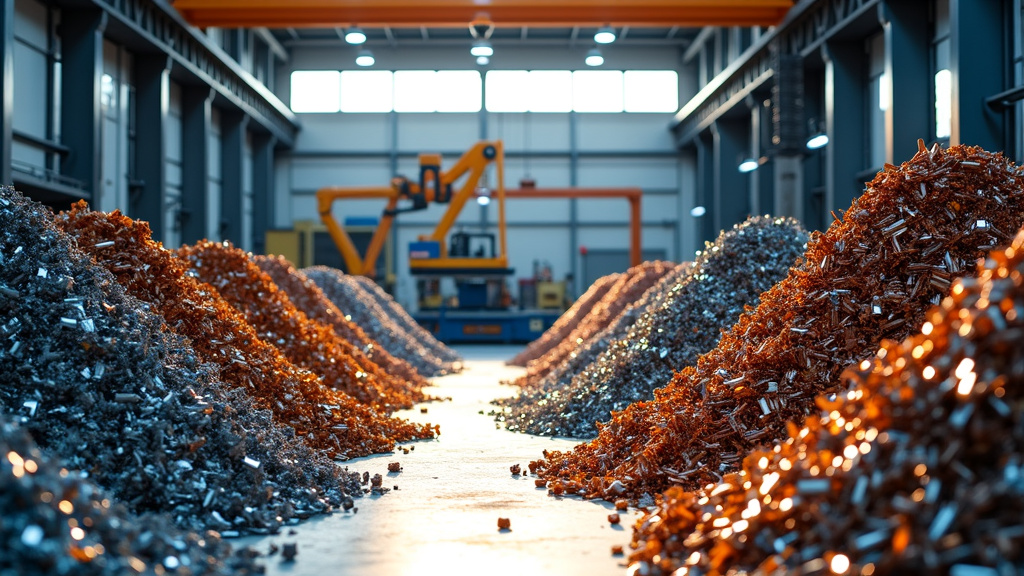5901 Botham Jean Blvd, Dallas, TX 75215
Industrial Symbiosis: A Key to Sustainable Manufacturing
March 23, 2025The growing importance of industrial symbiosis in modern manufacturing cannot be overstated.
As businesses face pressure to reduce their environmental footprint and optimize resource use, this approach offers a win-win solution. It allows companies to cut waste disposal costs, secure cheaper raw materials, and significantly reduce their carbon emissions, all while fostering innovation and creating new business opportunities.
Take, for example, the renowned Kalundborg Symbiosis network in Denmark. Here, a power plant’s excess steam heats local homes and businesses, while its fly ash is used in cement production. A pharmaceutical company’s waste becomes fertilizer for nearby farms. This intricate web of resource sharing has cut costs for participating businesses and dramatically reduced the region’s overall environmental impact.
As we explore the concept of industrial symbiosis, we’ll examine how this approach is transforming sustainable manufacturing, the tangible benefits it offers to businesses and communities, and the challenges that need to be overcome for its wider adoption.
What is Industrial Symbiosis?
At its core, industrial symbiosis is a collaborative approach where different industries exchange materials, energy, water, and by-products, creating a synergy that benefits both the environment and the economy. This concept is gaining traction as a crucial strategy for sustainable manufacturing and waste reduction in our resource-constrained world.
Imagine a manufacturing ecosystem where one company’s waste becomes another’s raw material, energy is shared and recycled, and water flows in efficient cycles between facilities. This is the promise of industrial symbiosis, a concept that is not just theoretical but is being successfully implemented in industrial parks and regions globally.
The Core Principles of Industrial Symbiosis

Industrial symbiosis is an innovative approach to resource management, inspired by natural ecosystems. It is based on three key principles that work together to create a more sustainable and efficient industrial landscape.
Resource Sharing: Turning Waste into Wealth
The first principle is resource sharing. Companies see their waste streams not as burdens but as valuable resources for other industries. A prime example is Kalundborg, Denmark, where a power plant’s excess steam is used by a nearby pharmaceutical facility, eliminating the need for additional energy generation.
This collaborative approach extends beyond energy sharing. Materials once destined for landfills find new uses. For instance, waste gypsum from air pollution control systems becomes a crucial ingredient in construction panels, showing how one industry’s byproduct can become another’s raw material.
Waste Reduction: Closing the Loop
The second principle focuses on reducing waste across the industrial ecosystem. By finding innovative uses for byproducts, companies can decrease the amount of waste sent to landfills or released into the environment, conserving resources and minimizing environmental impact.
In the UK, the National Industrial Symbiosis Programme (NISP) has shown the potential of this approach. Through facilitated exchanges, the program has diverted 39 million tonnes of CO2, highlighting the environmental benefits of industrial symbiosis.
Mutual Economic Benefit: A Win-Win Proposition
The third principle highlights the economic advantages of industrial symbiosis. Transforming waste streams into resources can reduce raw material and disposal costs while creating new revenue streams as byproducts find markets in other industries.
The economic impact can be substantial. Participants in the UK’s NISP program reported generating £1.3 billion in additional sales while saving over £1.3 billion in costs. This dual benefit of increased revenue and reduced expenses incentivizes companies to adopt industrial symbiosis.
Industrial symbiosis represents a shift in how we view waste and resource management. By embracing resource sharing, waste reduction, and mutual economic benefit, industries can create a more sustainable economy. This approach mimics the efficiency of natural ecosystems and paves the way for a more resilient and environmentally responsible industrial future.
Benefits of Implementing Industrial Symbiosis

Industrial symbiosis is a transformative approach to sustainable industry, offering numerous advantages for both businesses and the environment. By fostering collaborative relationships among industries to optimize resource use and minimize waste, this model is gaining traction worldwide as a key strategy in the circular economy.
A significant benefit of industrial symbiosis is the substantial cost reduction it offers to participating companies. By exchanging materials, energy, and services, businesses can dramatically lower their expenses for raw materials and waste management. For instance, the steel and aluminum industries have demonstrated notable success in implementing symbiotic relationships, leading to significant savings.
Environmental benefits are equally compelling. Industrial symbiosis contributes to a marked decrease in carbon emissions and resource consumption. A prime example is the city of Kwinana in Australia, where industrial symbiosis practices have resulted in avoiding the disposal of approximately 25,000 tons of waste annually and reducing CO2 emissions by about 100,000 tons per year.
Driving Innovation and New Market Opportunities
Beyond cost savings and environmental gains, industrial symbiosis serves as a catalyst for innovation. By encouraging companies to view waste streams as potential resources, it sparks creativity and leads to the development of new products and processes.
This innovative mindset often translates into new market opportunities. Companies engaged in industrial symbiosis frequently discover novel applications for their byproducts, opening up additional revenue streams. For example, in the Kalundborg Industrial District in Denmark, what began as a simple material exchange area in the 1960s has evolved into a complex network of resource sharing among major industrial players.
The Kalundborg symbiosis now includes collaborations between diverse entities such as the world’s largest insulin producer, Novo Nordisk, and Northern Europe’s largest wastewater treatment plant. This longstanding example demonstrates how industrial symbiosis can foster long-term economic resilience and innovation.
Enhancing Corporate Sustainability and Image
In an era where corporate sustainability is increasingly valued by consumers and investors, industrial symbiosis offers companies a tangible way to improve their environmental credentials. By actively participating in resource efficiency and waste reduction initiatives, businesses can significantly enhance their corporate image.
Consider the Burnside Park eco-park in Halifax, Nova Scotia. Here, institutional support has helped 1,500 companies improve their environmental performance through strategic relationships and a commitment to changing business practices. This large-scale adoption of symbiotic principles not only benefits the environment but also positions participating companies as leaders in sustainability.
Moreover, the improved corporate image resulting from industrial symbiosis can lead to better stakeholder relationships, increased customer loyalty, and potentially easier access to capital from environmentally conscious investors. It’s a win-win situation where economic benefits align perfectly with environmental stewardship.
Fostering Community and Economic Development
The benefits of industrial symbiosis extend beyond individual companies to positively impact entire communities. By creating interconnected networks of businesses, these initiatives often lead to job creation and local economic development. The Taiga Nova Eco Industrial Park in Fort McMurray, Alberta, Canada, exemplifies this community-centric approach.
Completed in 2011, this 131-acre facility provides space for environmentally friendly businesses, fostering a fair relationship between the environment and the economy while providing valuable services to the community. Such eco-industrial parks not only drive sustainability but also contribute to the overall economic health of the regions they serve.
In conclusion, the benefits of implementing industrial symbiosis are multifaceted and far-reaching. From significant cost reductions and environmental improvements to driving innovation and enhancing corporate image, this approach offers a compelling path forward for industries seeking to thrive in an increasingly sustainability-focused world. As more businesses recognize these advantages, industrial symbiosis is poised to play a crucial role in shaping a more circular and sustainable global economy.
How Okon Recycling Can Help with Industrial Symbiosis

In sustainable industry practices, industrial symbiosis is a powerful strategy for resource optimization and waste reduction. Leading this innovative approach is Okon Recycling, a company with over a century of expertise in metal recycling. Their role in facilitating industrial symbiosis is crucial and multifaceted, offering businesses a pathway to more efficient and environmentally friendly operations.
Industrial symbiosis involves different industries sharing resources and byproducts in a way that benefits all parties involved. Okon Recycling’s deep understanding of metal recycling processes positions them uniquely to bridge gaps between various sectors, turning one industry’s waste into another’s valuable input.
With their innovative recycling solutions, Okon helps businesses integrate seamlessly into symbiotic networks. This integration is not just about disposing of waste; it’s about reimagining the entire lifecycle of materials within industrial ecosystems. By doing so, they’re not only reducing waste but also fostering a more circular and sustainable economy.
Expertise in Handling Diverse Scrap Metal Types
One of Okon Recycling’s key strengths lies in their ability to handle a wide variety of scrap metal types. This versatility is crucial in the context of industrial symbiosis, where different industries produce diverse types of metal waste. From common metals like steel and aluminum to more specialized alloys, Okon’s expertise ensures that virtually no metal goes to waste.
Their advanced sorting and processing techniques allow for the efficient separation of different metal types, even from complex mixed waste streams. This capability is particularly valuable in industrial symbiosis, where the purity and quality of recycled materials can significantly impact their reusability in other industrial processes.
Moreover, Okon’s expertise extends to handling hazardous or contaminated metal waste, ensuring that even the most challenging materials can be safely recycled and reintegrated into the industrial cycle. This comprehensive approach to metal recycling opens up new possibilities for resource sharing among diverse industries.
Facilitating Efficient Resource Sharing
Okon Recycling acts as a crucial intermediary in the industrial symbiosis network, facilitating the efficient sharing of resources between different companies. Their role goes beyond simply collecting and processing scrap metal; they actively work to match waste producers with potential users of recycled materials.
This matchmaking process is vital for creating effective symbiotic relationships. Okon’s deep industry knowledge allows them to identify opportunities where one company’s metal waste can serve as a valuable input for another’s manufacturing processes. By doing so, they help create closed-loop systems that minimize waste and maximize resource utilization.
Furthermore, Okon’s state-of-the-art recycling facilities ensure that the quality of recycled metals meets the high standards required by various industries. This quality assurance is crucial for building trust in the industrial symbiosis network and encouraging more businesses to participate in resource-sharing initiatives.
Driving Waste Reduction Across Industries
The impact of Okon Recycling’s work in facilitating industrial symbiosis extends far beyond the immediate benefits to participating companies. By enabling efficient metal recycling and resource sharing, they contribute significantly to overall waste reduction across multiple industries.
This reduction in waste has profound environmental implications. It decreases the demand for virgin metal extraction, which is often energy-intensive and environmentally damaging. Additionally, by keeping metals in circulation, Okon helps reduce the amount of waste ending up in landfills, thereby mitigating soil and water pollution risks.
The economic benefits of this waste reduction are equally significant. Companies participating in the industrial symbiosis network facilitated by Okon can often reduce their raw material costs and waste disposal expenses. This cost-saving aspect makes industrial symbiosis an attractive proposition for businesses looking to improve their bottom line while enhancing their environmental performance.
Conclusion: Building a Greener Future with Industrial Symbiosis
Industrial symbiosis is more than just a sustainability trend — it’s a smart, forward-thinking approach that transforms waste into opportunity, reduces costs, and fosters collaboration across industries. From resource sharing and waste reduction to driving innovation and strengthening communities, the benefits are clear and far-reaching.
Companies like Okon Recycling play a pivotal role in making this vision a reality. By expertly managing diverse scrap materials and connecting industries in meaningful ways, they help businesses reduce their environmental impact while boosting efficiency and profitability.
As industries face increasing pressure to operate sustainably, embracing industrial symbiosis isn’t just good for the planet — it’s good for business. Now is the time for forward-looking companies to harness the power of collaboration, turning byproducts into resources and building a more resilient, circular economy for the future.
Contact Okon Recycling at 214-717-4083 to learn how you can contribute to a more sustainable future.
